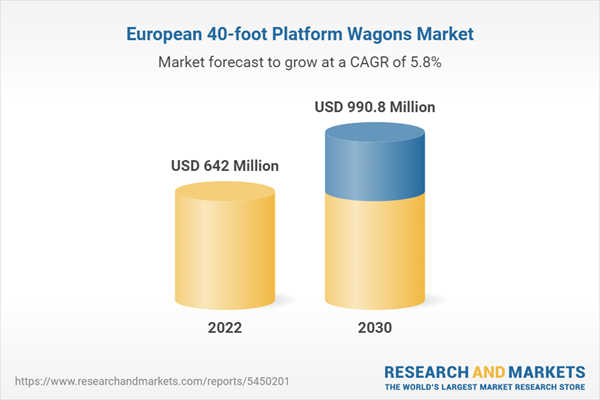The Europe 40-foot platform wagons market size is expected to reach USD 990.8 million by 2030, registering a CAGR of 5.8% during the forecast period, according to the report. The European Union (EU) significantly relies on the efficiency of rail transportation to haul freight for all industries that play an important role in driving the economy. Promoting more efficient and sustainable transportation of rail freight has been a key part of the EU policy. The development of favorable government strategies for rail freight operations can provide an opportunity to evaluate the current process and identify the potential scope for the current and future requirements of rail freight wagons.
The high capital investments required to rollout the railway infrastructure is one of the major restraints hampering the growth of the market. Rail projects can be considerably expensive owing to the huge investments required in having the necessary infrastructure in place. Moreover, rail operators need to continuously invest in upgrading the rail lines and power lines and installing new tracks, among other activities. Around 70% of the investments are spent on track infrastructure to ensure an efficient and safe network. This includes the replacement of rail and the construction of bridges and power lines. For instance, in June 2021, Rail Cargo Group, a rail freight transportation company based in Austria, announced an investment of USD 235.5 million to buy 2,150 freight wagons by 2026.
The growing demand for mobility in Europe has created a need for a well-integrated and efficient railway system capable of addressing all the logistical, technical, and environmental constraints and ensuring sustainable growth of the enlarged European Union. Replacing legacy technology with advanced train-control and signaling systems, such as European Rail Traffic Management System (ERTMS) Level 2 and above, which is based on wireless communications to supervise the train movement, can be considered the core element for the digitization of traffic management and train control. Advanced technologies, such as freight information systems, Positive Train Control (PTC), machine vision, and RFID, are unfolding new opportunities for reducing logistics costs, improving operational efficiency, and enhancing customer service while providing personalized door-to-door delivery.
The high capital investments required to rollout the railway infrastructure is one of the major restraints hampering the growth of the market. Rail projects can be considerably expensive owing to the huge investments required in having the necessary infrastructure in place. Moreover, rail operators need to continuously invest in upgrading the rail lines and power lines and installing new tracks, among other activities. Around 70% of the investments are spent on track infrastructure to ensure an efficient and safe network. This includes the replacement of rail and the construction of bridges and power lines. For instance, in June 2021, Rail Cargo Group, a rail freight transportation company based in Austria, announced an investment of USD 235.5 million to buy 2,150 freight wagons by 2026.
The growing demand for mobility in Europe has created a need for a well-integrated and efficient railway system capable of addressing all the logistical, technical, and environmental constraints and ensuring sustainable growth of the enlarged European Union. Replacing legacy technology with advanced train-control and signaling systems, such as European Rail Traffic Management System (ERTMS) Level 2 and above, which is based on wireless communications to supervise the train movement, can be considered the core element for the digitization of traffic management and train control. Advanced technologies, such as freight information systems, Positive Train Control (PTC), machine vision, and RFID, are unfolding new opportunities for reducing logistics costs, improving operational efficiency, and enhancing customer service while providing personalized door-to-door delivery.
Europe 40-foot Platform Wagons Market Report Highlights
- In France, digitalization and automation are driving the future of connected, autonomous, and digital freight trains to deliver better services to customers. For instance, the increasing e-commerce sales and government investments in intermodal transportation have propelled rail freight operators to boost local transportation services to facilitate the efficiency of day-to-day logistics
- Fret SNCF, a rail freight operator, partnered with Traxens, a Marseille-based company specializing in smart containers, to enable rail freight operators to track shipments in real-time, monitor mileage, record the movements of freight wagons, and receive alerts when shipments reach predefined locations
- In Poland, the railway sector invests significantly through its most extensive investment program, which offers business opportunities for Swiss exporters. The investment program aims to construct and modernize 9,000 km of tracks, existing infrastructure, tunnels, overpasses, and bridges for high-speed trains
- In August 2019, PKP Intercity, a company responsible for long-distance rail passenger transport, invested USD 2.2 billion to modernize 700 wagons, 14 new train sets, and 200 electric and diesel locomotives. The company also procured 185 wagons, 19 new train sets, and 118 electric and diesel locomotives
Table of Contents
Chapter 1. Methodology and Scope
Chapter 2. Executive Summary
Chapter 3. Europe 40-foot Platform Wagons Market Variables, Trends & Scope
Chapter 4. Europe 40-foot Platform Wagons Market: Country Estimates & Trend Analysis
Chapter 5. Europe 40-foot Platform Wagons Market: Regional Estimates & Trend Analysis
Chapter 6. Competitive Landscape
List of Tables
List of Figures
Companies Profiled
- S.C. Astra Rail Industries S.A
- ELH Waggonbau Niesky GmbH
- NYMWAG CS a.s.
- RM RAIL
- Tatravagónka a.s.
- UWC RPC PJSC
- VTG GmbH
- Rostec
Methodology

LOADING...
Table Information
| Report Attribute | Details |
|---|---|
| No. of Pages | 60 |
| Published | November 2023 |
| Forecast Period | 2022 - 2030 |
| Estimated Market Value ( USD | $ 642 Million |
| Forecasted Market Value ( USD | $ 990.8 Million |
| Compound Annual Growth Rate | 5.8% |
| Regions Covered | Europe |









